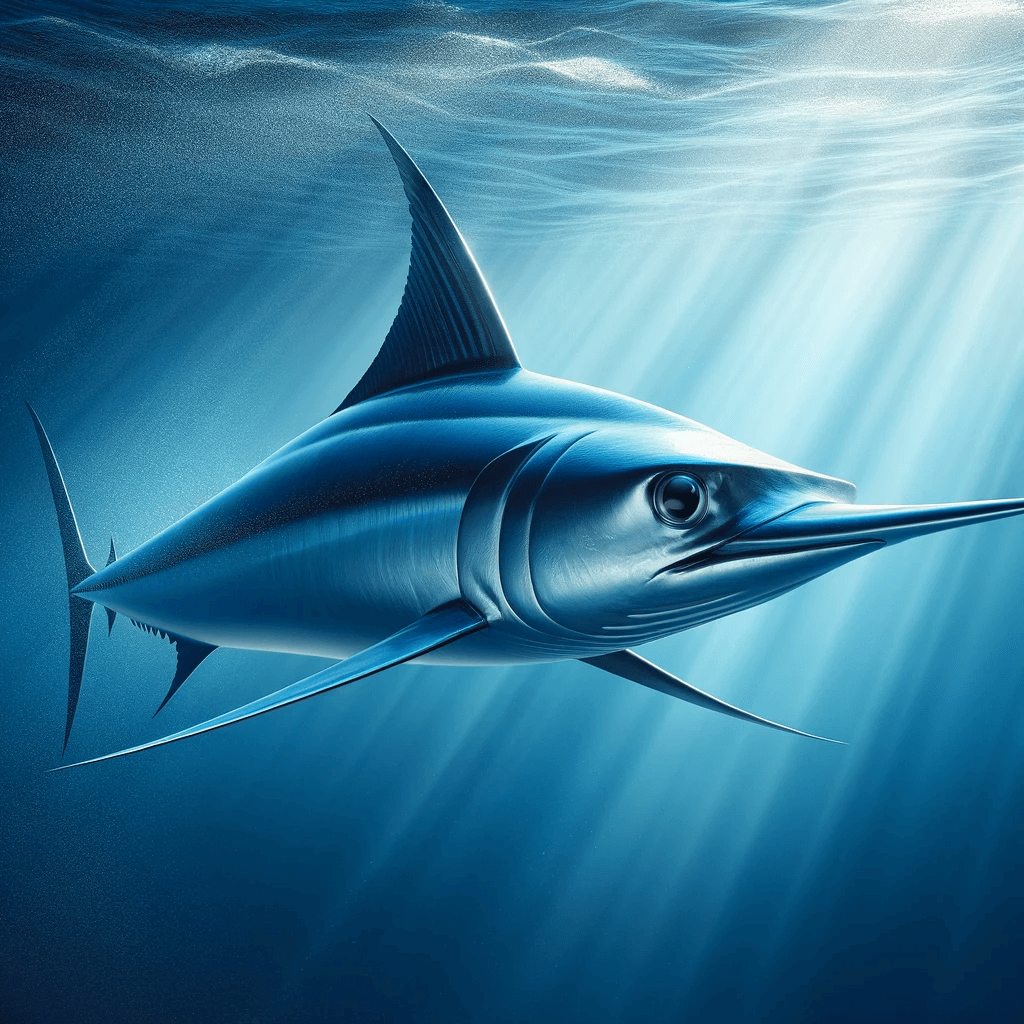As an enthusiast in the combat against heart disease, I’m here to guide you through a sea of dietary choices. Specifically, I’ll navigate you away from the treacherous waters of certain fish that could undermine your heart health.
Understanding Heart Disease and Fish Consumption
Let’s take a moment to consider the link between heart disease and fish. It’s widely recognized that fish is a heart-healthy food, rich in Omega-3 fatty acids that are known to reduce inflammation. However, not all fish are beneficial. Some carry risks that far outweigh their benefits, especially for those with heart disease. Let’s name them all!
#10: Marlin

As we sail into our countdown with the majestic Marlin, this titan of the sea commands respect. The marlin, with lengths that can soar to 14 feet and weights that tip the scales at over 1,500 pounds. Their sheer size and prowess render them an oceanic phenomenon.
The Hidden Danger Beneath the Surface
But the Marlin’s grandeur masks a hidden adversary to our health – mercury. The EPA sets the bar at 0.3 ppm for methylmercury in fish tissue. Yet Marlins can exhibit levels soaring to a staggering 3.0 ppm. This concentration is a full tenfold beyond what is deemed safe.
Mercury’s Cardiovascular Betrayal
The tie between mercury intake and heart disease cannot be ignored. It’s a correlation that has emerged from the depths of research. With a notable study in the “New England Journal of Medicine”. Painting a grim picture of a 60% spike in heart disease risk for men harboring higher mercury levels. This foe not only wreaks havoc on adult hearts but also casts a shadow over the developing minds of the young. Threatening to dial down a child’s IQ before they’ve even taken their first breath of ocean air.
#9: Orange Roughy
Diving deeper into the abyss, we encounter the Orange Roughy, a fish that is the very definition of longevity. With lifespans that can cross the 150-year threshold. These denizens of the deep grow at a glacial pace, reaching maturity only after three decades have passed – a leisurely ascent to adulthood.

The Price of Longevity
But with age comes a heavy burden. The slow and steady life of the Orange Roughy is one laden with toxic buildup. Accumulating heavy metals in their seasoned bodies. Their flesh can often carry mercury levels of 0.4 ppm. Casting a dark cloud over the EPA’s safety limit and hinting at a sinister cocktail of arsenic and lead that rides the currents alongside mercury.
The Cost of Endurance
The prolonged exposure of these fish to the sea’s contaminants translates directly to our plates. bringing with it not just flavor, but the specter of inflammation, neurological strife, and cardiovascular woes. Their life story is not only one of environmental endurance but also a narrative of the dangers lurking within our seas, calling for a thoughtful consideration of what we let swim into our diet.
#8: Tilefish from the Gulf of Mexico

Anchoring the eighth spot on our list, Tilefish from the Gulf of Mexico paint a complex picture of marine life. These fish, with their extended lifespans, often crossing the 35-year mark, sit at the apex of their food chain, which comes at a cost.
The Apex Predators’ Dilemma
Their position at the food chain’s zenith enables a concerning level of mercury absorption. Studies have revealed that these fish can harbor mercury from 0.144 to an alarming 3.220 ppm. This range not only breaches the EPA’s safety line but also paints a stark portrait of the broader implications on human health, from heart disease. A specter looming over millions – to disruptions that cascade through endocrine and immune systems.
The Lessons from Minamata
History whispers warnings through events like Minamata’s mercury poisoning, highlighting the profound impacts these elements can have on our health. Yet, there’s wisdom to be found in the paradox of the Mediterranean, where high mercury levels in the sea contrast sharply with the low disease rates among its people. It’s an ode to the virtues of small fish and short lifespans, serving as a reminder that our choices have power – the power to protect not only our hearts but also the vast blue that cradles life beneath its waves.
#7: Sharks
Sharks, the formidable rulers of the ocean depths, occupy the seventh rung on our list. As awe-inspiring as they are feared, sharks carry with them an unwelcome payload of mercury, making them a problematic choice for those mindful of their diet.

Bioaccumulation in the Ocean’s Apex Predators
With mercury levels that can ascend to 1.45 ppm, these predators collect toxins in their bodies over many years – decades and even centuries for species like the Greenland Shark. A direct relationship has been unearthed between the age and size of sharks, especially in species like the Shortfin Mako Shark, and their mercury content. The longer they reign, the more they gather – a dangerous bounty that poses a significant risk to those who consume their meat.
Ecological and Health Impacts
Sharks’ plight isn’t limited to their mercury burden. Environmental consequences arise from the dining table to the deepest trenches, where practices like overfishing and the cruel act of shark finning deplete their numbers. The call for sustainable fishing and conscientious consumption is loud and clear, a plea to preserve the health of our oceans and ourselves.
#6: Swordfish

In the sixth position, the Swordfish cuts an imposing figure. Known for its pointed bill and swift movements, this predatory fish is infamous for its high levels of mercury.
The Migratory Mercury Carriers
Research unveils alarming figures with average mercury concentrations of 0.995 ppm, and in some instances, levels spike to a hazardous 3.22 ppm. Swordfish traverse oceans, and their vast journeys expose them to diverse sources of mercury. As they hunt and feast on smaller fish, the mercury climbs the food chain, culminating in a concentration that poses significant risks to human health.
Health and Environmental Considerations
Consuming swordfish isn’t just a gamble with one’s health – particularly concerning for the brain and developing bodies – but also a matter of global concern. Organizations like the International Seafood Sustainability Foundation labor to oversee the stocks of swordfish, aiming to secure a future where these fish can continue their oceanic voyages without the shadow of extinction.
#5: King Mackerel
Securing the midpoint of our list is the King Mackerel, a fish as renowned for its taste as it is infamous for its mercury content.

A Predatory Problem
Growing to lengths of over 5 feet and weights surpassing 100 pounds, this fish is a significant carrier of mercury, with levels often exceeding the concerning threshold of 0.7 ppm. The predatory diet of the King Mackerel amplifies this accumulation, leading to high concentrations of mercury and other toxins like PCBs within its muscular frame.
A Health Hazard
The health implications of consuming King Mackerel are vast, stretching from the subtlest of neurological impairments to overt cardiovascular challenges and kidney damage. The risks are especially dire for pregnant women, nursing mothers, and young children, who face the possibility of developmental and cognitive delays. The advice is clear and urgent: those most vulnerable should steer clear of the King Mackerel to navigate away from the risks associated with its consumption.
#4: Basa Fish

The Basa fish, also known as Vietnamese catfish, secures the fourth position on our list, with concerns surrounding its farming and consumption drawing global attention.
Contamination Concerns in Catfish Aquaculture
Originating from the heavily polluted Mekong River, Basa fish farming is fraught with issues stemming from industrial and agricultural runoff. The European Food Safety Authority has sounded alarms, finding that a staggering 90% of Basa fish samples harbored high levels of PCBs, which breach the safety levels for human consumption.
The Chemicals and Antibiotics Quandary
Further complicating matters, the Environmental Justice Foundation has reported the use of banned substances in the cultivation of Basa, including dangerous chemicals and antibiotics. This alarming statistic suggests that half of the Basa farms utilize hazardous materials in their production processes, presenting significant health threats to consumers.
Navigating Safe Consumption
To avoid these risks, consumers are encouraged to thoroughly investigate the sourcing and certification of Basa fish. Opting for products that have clear traceability can mitigate the health dangers associated with this type of seafood.
#3: Tilapia
Tilapia, a commonly consumed fish in America, comes in at number three, with its health benefits being compromised by its dietary makeup.

Dietary Composition Caveats
USDA reports have illuminated a dietary dilemma: the disproportionate ratio of omega-6 to omega-3 fatty acids in Tilapia. With omega-6 amounts surging to levels tenfold that of omega-3s, this could provoke inflammatory responses, a concern underscored by nutrition experts.
Import Safety and Rejections
Adding to the apprehension, FDA data reveals a high rate of Tilapia import rejections, pointing to the presence of toxic substances such as malachite green and tetracycline. These substances carry the risk of cancer and contribute to the growing issue of antibiotic resistance.
Certification and Consumer Guidance
For those who wish to continue enjoying Tilapia, seeking out the Best Aquaculture Practices (BAP) certification can be a safeguard. This label on packaging assures consumers of adherence to standards that elevate both the quality and safety of the fish.
#2: Farmed Shrimp

Farmed shrimp clinch the second spot, with their production practices and the implications for heart health sparking substantial concern.
Antibiotic Overuse in Shrimp Farming
A study published in “Science Advances” points to an unsettling reality: the widespread use of antibiotics in shrimp aquaculture. This practice has led to an overwhelming majority of shrimp carrying bacteria resistant to antibiotics, posing a direct threat to consumer health.
Mislabeling and Market Confusion
Oceana’s investigation into shrimp mislabeling reveals that up to 30% of shrimp products are incorrectly labeled, complicating the efforts of consumers to make ethical and healthy seafood choices.
Import Regulations and Consumer Tips
With the FDA rejecting a fifth of shrimp imports due to contamination, it’s crucial for consumers to be vigilant. Certifications like the Marine Stewardship Council (MSC) and Aquaculture Stewardship Council (ASC) are indicators of shrimp that have met stringent sustainability and safety standards. These labels, distinguished by their blue and green colors, act as a beacon for those seeking seafood that supports heart health and sustainability.
#1: Deep-Fried Batter
At the top of the list for heart health hazards is not a specific type of fish, but rather a common culinary technique that transforms even the healthiest fish into a risky meal for heart health: deep-frying in batter.

The Transformation of Healthy Fish to Health Hazard
The process of deep-frying fundamentally changes the nutritional profile of fish. Rich in proteins and essential nutrients, fish is considered a heart-healthy option. However, once it is encased in batter and deep-fried, it becomes laden with unhealthy carbohydrates and fats.
The Use of Low-Quality Oils
Many restaurants may use oils that are cheap and can withstand high heat for repeated use, which often means they are high in saturated and trans fats. These fats are particularly bad for heart health, contributing to increased cholesterol levels and risk of heart disease.
Health Surveillance Statistics
Robust data from health studies indicates a 23% increased risk of heart failure associated with regular consumption of deep-fried foods. This risk is exacerbated by the use of batter, which adds extra calories and unhealthy fats.
Advanced Glycation End-Products (AGEs)
When food is fried at high temperatures, especially with added sugars in the batter, it leads to the formation of AGEs. These compounds are implicated in causing oxidative stress and inflammation, both of which are risk factors for atherosclerosis and coronary artery disease.
Increased Risk with Each Serving
The danger of consuming fried foods is quantifiable, with studies suggesting that for every additional 114 grams of fried food consumed per week, the risk of heart attack or stroke climbs by 12%. This is particularly alarming for lovers of deep-fried battered fish, which might be served in even larger portions.
Making Heart-Healthy Choices
To combat the risks associated with deep-fried fish, it’s recommended to choose alternative cooking methods. Baking, steaming, or grilling not only preserve the heart-healthy benefits of fish but also avoid the addition of harmful substances formed during the frying process.
Conclusion and Dietary Advice
In conclusion, while fish itself is a healthy addition to one’s diet, when it is prepared in a deep-fried batter, it becomes counterproductive to heart health. Awareness and making informed choices about how fish is cooked can be an essential step towards maintaining a heart-healthy diet. Choosing cooking methods that do not involve high temperatures and added fats is key to ensuring that fish remains beneficial in promoting cardiovascular health.
Spotlight on Ocean’s Heart-Health Heroes
While the aforementioned seafood items pose significant risks to heart health, it’s important to recognize the beneficial fish that can contribute positively to our diet. Some species of fish are considered “heroes” when it comes to cardiovascular health, packed with omega-3 fatty acids and other essential nutrients that fight inflammation and support heart function.
Atlantic Mackerel: Omega-3 Powerhouse
Atlantic Mackerel stands out as a heart-healthy fish due to its high content of omega-3 fatty acids, boasting 2.5 grams per serving. These essential nutrients are known for their anti-inflammatory properties and have been linked to a decreased risk of heart disease. It’s important to differentiate this type of mackerel from the King Mackerel, which, as mentioned earlier, contains high levels of mercury and is best avoided.
Wild-Caught Salmon: A Nutritional Multitasker
Following closely is wild-caught salmon, a well-known champion in the health food community. Just a single serving of salmon can provide a substantial dose of omega-3 fatty acids, along with vitamin B12 and vitamin D. These nutrients are vital for maintaining heart health and preventing chronic diseases.
Sardines: Small Fish, Big Benefits
Sardines may be small, but their contribution to heart health is significant. They offer over 1.5 grams of omega-3s, as well as essential calcium and vitamin E, with the added benefit of having minimal mercury content. These tiny fish are not only nutrient-dense but also a responsible choice for those concerned with environmental impact and sustainability.
Alignment with Health Recommendations
These fish are exemplary in aligning with the American Heart Association’s guidelines, which advocate for the inclusion of fatty fish at least twice a week in a heart-healthy diet. By providing high levels of omega-3 fatty acids without the risks associated with high mercury content, these fish help in reducing the likelihood of heart disease and promoting overall cardiovascular health.
Incorporating Heart-Health Heroes in Your Diet
To reap the benefits of these oceanic treasures, it’s recommended to incorporate Atlantic Mackerel, wild-caught salmon, and sardines into your weekly meal planning. Whether grilled, baked, or consumed in a salad, these fish can offer variety and nutritional benefits to everyone, especially those looking to maintain or improve their heart health.
Final Thoughts on Heart Health and Seafood Selection
When considering the health of your heart, particularly if you’re managing or at risk for heart disease, being selective about the seafood you consume is more than just a dietary preference—it’s a necessary aspect of maintaining your well-being. The top 10 fish listed, known for their high mercury levels, unfavorable fat compositions, or risky contaminants, should be approached with caution or, in some cases, avoided altogether. However, remember that seafood can still have a place in a heart-healthy diet; it’s about making informed, discerning choices.
Embracing fish rich in omega-3 fatty acids like Atlantic Mackerel (not its King counterpart), wild-caught salmon, and sardines can be beneficial for heart health. These selections are not only rich in essential nutrients but also low in the contaminants that can undermine the cardiovascular benefits of fish consumption.
For more insights, please watch this informative video:
Frequently Asked Questions
Why is deep-fried fish bad for heart health?
Deep-fried fish is detrimental to heart health because it is high in unhealthy trans fats and advanced glycation end-products (AGEs), which are linked to increased inflammation, oxidative stress, and an elevated risk of atherosclerosis and heart attacks.
Can I eat any fish if I have heart disease?
Yes, but choose wisely. Opt for fish high in omega-3 fatty acids and low in mercury, such as wild-caught salmon, sardines, and Atlantic Mackerel. These types of fish offer cardiovascular benefits without the risks posed by their high-mercury or contaminated counterparts.
How often can I safely eat seafood if I’m concerned about heart disease?
The American Heart Association recommends eating two servings of omega-3-rich fish per week. However, portions and frequency should be adjusted based on individual health needs and in consultation with a healthcare provider.
What should I look for when buying heart-healthy fish?
Look for certifications such as the Marine Stewardship Council (MSC) or Aquaculture Stewardship Council (ASC) labels that indicate sustainable and safer practices. Also, check for low mercury levels and a high omega-3 fatty acid content.
Are there any safe options for fried fish if I have heart disease?
It’s best to avoid fried fish if you have heart disease. Healthier cooking methods like baking, grilling, or steaming are preferable. If you must have fried fish, choose pan-frying in a small amount of healthy oil like olive oil, and avoid deep-frying.





